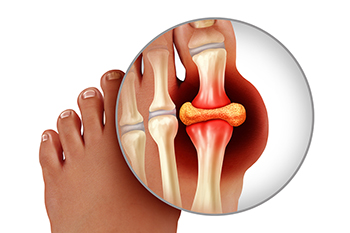
Gout is a form of inflammatory arthritis that targets your joints, and commonly affects the big toe. The most common symptoms of gout are burning, itching or tingling in the joint, followed by painful swelling and redness. Men are more apt to experience gout, but women are more at risk after menopause. Being overweight and eating foods that are high in purines are major contributors to this painful condition. Purines are more abundant in seafood, red meat (especially organ meat), fried and processed foods, and sugar. A byproduct of purines is uric acid, which sometimes forms into crystals that stay in the joints and cause pain. Gout can flare up and recede, so constant awareness of diet and weight is essential in reducing flare ups. It is wise to drink plenty of water, eat more fruits (especially those high in vitamin C) vegetables, and low-fat dairy products, as these foods are lower in purines. If you think you may be having a gout attack, it is suggested that you seek the help of a chiropodist at your earliest opportunity.
Gout is a painful form of arthritis that can affect anyone. Please consult with Chiropodist Stephanie Poupore from North Bay Foot & Ankle. Our clinician will assess your condition and provide you with quality foot and ankle treatment.
What Is Gout?
Gout is characterized by sudden, severe attacks of pain, redness, and tenderness in the joints. This type of arthritis is caused by a buildup of uric acid in the bloodstream. When uric acid crystallizes in a joint, often the joint of the big toe, it can bring about a gout attack.
Symptoms
Symptoms of gout include:
-
Sudden and severe pain
-
Swelling
-
Redness
-
Warmth
-
Joint stiffness
-
Joint deformity
Diagnosis
A chiropodist will ask questions about your personal and family medical history, followed by an examination of the affected joint. Laboratory tests and x-rays are sometimes ordered to determine if the inflammation is caused by something other than gout. A sample of fluid taken from your joint can show whether it contains uric acid.
Treatment
Prescription medications or injections are used to treat the pain, swelling, and inflammation. Patients with chronic gout can also use behavioral modifications such as diet, exercise, and decreased intake of alcohol to help minimize the frequency of gout attacks. Foods and beverages that are high in purines should be avoided since purines are converted in the body to uric acid. If left untreated, this painful condition can leave your joint permanently damaged and swollen.
If you have any questions, please feel free to contact our office located in . We offer the newest diagnostic and treatment technologies for all your foot care needs.
